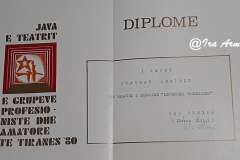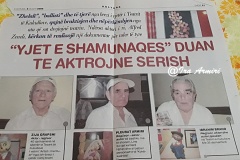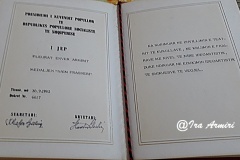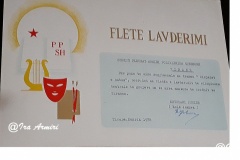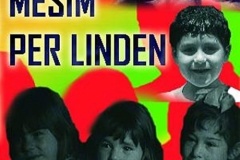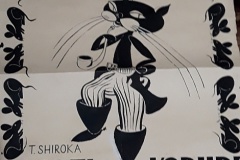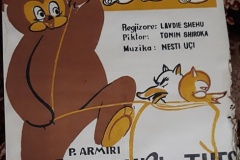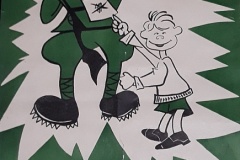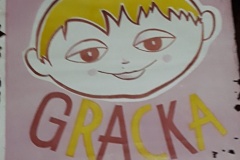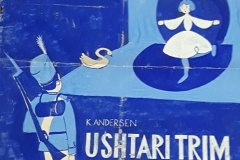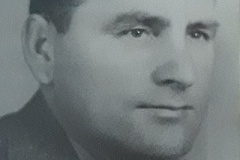Pleurat Armiri (1929-2008)
Actor, director and librettist of the Central Puppet Show. https://www.facebook.com/media/set/?set=a.3454436374616206&type=3
Armiri was born in Libohove on May 25, 1929, in an intellectual family. His parents, father Enveri, was a judge and mother Emineja a teacher, both graduated in Istanbul.
He was the third son of the family, of 4 sons, Vedati, Perlati, Pleurati and Myftari, from the 2 youngest ones, he and Myftari, would follow the path of art.
Pleurati spent the first years of his life in the movements that the family made because of his father’s work as a judge, in Delvina, in Ballsh, and then in Tirana, where they finally settled.
In the family and at school, he was taught the education of work, with its discipline (he first attended a technical school) and regardless of the fact that he devoted his whole life to art, he was always organized at work.
When he wrote, he would sit down and work for hours, stopping only for lunch or dinner, and when the working day was over, every sheet of paper was organized, the pen as well, ready for the next day.

Like most young people in the first years after the war, he is involved in amateur artistic activities in Tirana. Even during his military service in Korce, he continues to be part of the artistic activity.
Release from the army also marks the beginning of work in an artistic institution. It was 1952, when he was appointed to the Central Puppet Theater in Tirana. The newly formed theater was not just a new institution, but the first experience of this artistic genre in Albania.
They were a group of passionate artists, who opened a new path, a story that has been going on for decades and that involved the whole country.
While working, he completed his studies at Jordan Misja Artistic High School, in the drama department that was opened there. When the drama department at the Higher Institute of Arts opened its doors, in the theater “they had a lot of work, rehearsals” and they could not give permission to everyone to continue their studies without leaving work.

This is how a long artistic career began. He found himself in this genre, and regardless of the offer to work in the Estrade Theater, he decided to stay there in the world of puppets, in the beautiful world of children.
The work of the actor, the director and the author were naturally intertwined. At first he started as an actor. Throughout his career, until he retired, he would bring many roles to the stage, such as the parts “The Devil with Horns”, “The New Tooth”, “The Liar Pipiruqi”, “The Bloody Throne”, “Little Red Riding Hood”, “Ivan the Great”, “Shvejku”, “Don Quixote”, “Snow White”, “Aladdin’s Lamp”, “Cosette”, “Galoshja magjike”, “Coloured Beetle”, “Iron Fist”, “Little Brave”, “The Prefect”.
Various characters such as the little brother of “Pipiruqi the liar”, Nallban Jarani of “Gjergj Eleza Alia”, Man Kukaleshi of “The Prefect”, the sultan of “Castle and the poison”, the priest of “Ivan the Great”, the quaestor of “Day of the war” and many others.

He took another step in his artistic activity, when he started his directorial career in 1956, with the part “Bicikleta e postierit / Postman’s Bicycle”, written by Pandi Stillu. And in the same year he realized the second direction, of the part “Dysh ne artimetike”. As a director he had a rich activity, as he put on the stage of the puppet show many plays, during all the years of work in the theater but also after he`s retirement (1984), to close his career only in 1999, with the part he wrote himself “Kacamisri” and “Shtatepellembemjekri”, for which he worked together with Shegushe Bebeti.
He performed various quality parts on the stage, where he was applauded, also honored in the theater competitions, such as with Diplomas in the Theater Week of Professional and Amateur Groups of Tirana in 1980, for the puppet show “Lepurushi veshkaushi”.


His activity also included that as the author/librettist of the Puppet Theater.
In 1964, with the part “Variety for the New Year”, he appeared in front of young viewers as an author and director, to continue with many other parts over the years, until “Princesha e Pallatit te Arte” in 2001, co-author with Luigj Gurakuqi.
Of the parts that have been more prominent, we can mention: “The Little Brave” (first prize in the national competition, on the occasion of the 25th anniversary of the Liberation), “The Cave of Kreshniks”, “The Trap”, “Linda’s Mistakes”, ” Who entered into the sack”, “Kaposh kokeboshi”, “Lost egg”, “Circus artists”, “The lie has no legs at all”, “Three joys”, “Gishteza”, etc., etc.

Some of these parts have been published in Children’s Scene. One of the most successful pieces he made was “Kokekashta”, which he wrote based on the motives of the novel “The Adventures of Kokekashte” by Stavri Pone, also directing it.
The excellent interpretation of Mrs. Bakie Baboçi in the role of “Kokekashta”, the dolls created with more finesse and new materials by then very talented young sculptor Mrs. Majlinda Frasheri, gave the show a liveliness and the reception from the children was enthusiastic.
The show premiered in May 1993, and continued to air for years to come. It was also presented with dignity at an international festival in Graz, Austria.
Its special feature was that for the first time, in accordance with the newly approved law “On copyright” and VKM “On the reward of artistic quality”, he was rewarded for the entire period that the play was given on stage.
He never had this pleasure of artistic creation when he was in the theater, but at least he had an opportunity to prove the appreciation for his quality work and all the artists who made it.

I return again to the speech delivered by Zef Kurti, at the retirement ceremony, where, among other things, he says:
“In the parts written by Pleurati, I note with satisfaction that the jokes are short, something that the child manages to assimilate. And not only that, but in his parts action predominates, action is primary. The jokes in the part are not ordinary, but rich in thoughts, in humor, with taste and beauty of expressions”.
This way of writing came from a deep knowledge of the world of children, of their psychology, and from the awareness that the piece should convey messages and arouse positive feelings. It was his constant dedication that the part responded to the interest of the children, and not to the bureaucratic demands for the subject.

Throughout his life he was a supporter of the existence and progress of the puppet theatre, as a special genre. Theater only with people, it’s another gender, he said. He himself practiced the participation of actors and puppets in the same part, having a complete success with “Kokekashta” or “Gishteza”.
But the doll should be present in every part. With his work, he created successful shows and tours throughout Albania with a large number of small viewers. Hundreds of hours of broadcast on RTSH, for radio listeners and viewers of the small screen, of written parts, performed on stage by him, in the Central Theater of Puppets, or in other theaters.
Only in the directing work, in the theater, he regularly realized 2 of the 5 premieres that were planned every year, from the late 70’s until he retired in 1984, tirelessly, with true love and passion for art.
There were fruitful collaborations with fellow writers, for the co-authorship of several works, with Gaqo Bushaka for the piece “Gracka” for which he also directed, with Cezar Ruhi, with Bedri Dedja, when he staged the latter’s dramatization of the tale of Andersen’s “Brave soldier made of lead”, or Tonin Shiroka for the piece written by him “Daci i zi me dy kobure”, where he was the director, etc.
He also collaborated with puppet theaters throughout Albania, from Korca with director Drita Kallamata, in Sarande with director Taqo Lepuri, in Erseke with director Anastas Rrushi, in Fier with Arqile Licin, in Durres with Halit Stojku (in the 90s) until in Burrel with Elmaz Osman and in Bajram Curri.
These collaborations continued for as long as he was active, when he worked in the theater and then when he retired. The parts written by him were played and had success in those scenes as well. I can’t leave without mentioning here the long and fruitful collaboration with the composer and theater player Mr. Nesti Uçi and with the painter and scenographer, and the author Mr. Tonin Shiroka, the performing painter Mr. Hamdi Halluni.
No matter how different the professions or natures were, making a successful show always united them.
I remember with pleasure, that when he came from work or tours, he would always mention the humor and jokes with these colleagues, and I believe that working together gave them the opportunity to be good friends.
He had a long and productive collaboration with the director Lavdie Toro, who was one of those artists who dedicated herself to this genre, producing quality parts and creating her good name. A good part of the pieces he wrote were staged by Lavdia, proving that the collaboration was welcomed by both. Like other colleagues, he also worked for the preparation of professionals, in this genre of art, in the studios that were organized in the theater (as there was no specific branch for puppet theater in Albania, in the then Institute of Arts), with talented young people from all over Albania.
Pleurati has also written research articles in professional magazines, such as “Using, moving and synchronizing the doll” in the Skena and Screen magazine, no. 4, year 1981 and in the “Little Scene and Puppet”. There was no lack of his contribution even outside the puppet theater.
He was the director of the amateur group of the Central Ambulance (as today’s Clinic of Specialties was known at that time). With her troupe, he also participated in amateur and professional theater festivals in Tirana.
In the Olympiad of the best groups in Tirana, in 1978, he received a certificate of praise from the Olympiad, for good directing work in the part “Signals of the Night”, with which the Central Ambulance troupe participated in this Olympiad.
In his long career, talent, work and passion for art were determinants of professional success and satisfaction. He was not the first to look favorably on the monist state. The problems of the biography were those that would be mentioned again and again and emphasized, every time the class war intensified, and the Albanian society went through artificial internal crises, which should take attention away from the basic problems (the crumbling economy and the terrible isolation). , finding enemies.
The works would be criticized, for ideological mistakes, and would remain in the drawer for years, such as “Lost egg”, or “Kaposh kokeboshi”. The success of the parts written by him, and performed on stage, would be permanent, but the evaluation given to him was half-hearted, “for good work”, “for the realization of roles with a good artistic level”.
The officials were afraid of falling into the lap of the “enemy” if they evaluated him as his work should be. So the official evaluation was a real misery. At a time, when the copyright was only a definition in the constitution of the dictatorship, but never a right in implementation that would give each creator the appropriate reward, even the assessment in words was lacking, feared.
The official evaluation at the end of a long and successful career is a work medal, “for the realization of roles with a good artistic level”.
Even since the 65th anniversary of the theater, he is mentioned as an actor, when for a long period, in the lobby of that institution (the only Hall of Fame of artists of this gender in Albania) his photo was next to those who the honorable and fully deserved librettist designation. Honor that continued until 2013!?
It seems that the later directors were remembered for the former enemy, now he is only an actor, that’s how he got the appointment. What about the contribution?!
Fortunately, he did not live to face such humiliation.
He left this life on 20.12.2008.
Regardless of the official treatment, art was the one that rewarded him every day, it was the knocking of the children in the show. It was the satisfaction that the actors and his collaborators in the realization of the premieres felt while working with him.
As he remembers in his speech Mr. Zef Kurti: “Work, work, always work! – here’s what Pleurati would advise you, so that you can achieve what you dreamed of, to feel that even the doll, like the spoken role, becomes yours.”
And he said these words, because as a director he believed that if the artist had talent, he would reach the maximum with work. He realized his dreams there on stage. Characters, parts written or directed by him came to life. He always appreciated his fellow actresses who acted with him or made up the group that worked for a show. He knew their talent and dedication, the fatigue and often the sacrifices they made to bring out the right characters. He knew and appreciated the artistic figure they created. They were not just colleagues but also friends, Xhavit Xhepa, a friend since childhood, (whose untimely loss he suffered a lot).
And Zija Grapshi, Drita Kallamata, Rina Toro, Eleni Plasari, Bardhyle Nase Lin Noka, Ibrahim Braho, Meliha…, Bakie Baboci, Lorenc Pepa, Mirketa Cobani, Eva Pellumbi, Mira Minga, Florinda Mazreku, Marilda Furxhi, Shegushe Bebeti, etc. He also raised his family with his fellow actress Liri Dhimitri, with whom he became involved in the theater.
He never wrote memoirs about his artistic life, few photos are from his working days, many with colleagues, friends, in his free time, between shows, on tour, some of the posters of the shows. It was enough for him the satisfaction that the scene gives him directly and when he likes the part, he gives it without saving. He did not think about eternity, he saw life as continuous regeneration, other generations with their passion and ideas, continue the work started.
That’s how I felt it was my duty to write these lines for a portrait, for Pleurat Armir (my father), one of the most important creators of Albanian art, in a beautiful, special genre that gives you unusual pleasure, the applause of children , the sparkle in their eyes.
SOME OF THE PIECES WRITTEN BY PLEURAT ARMIRI FOR PUPPET THEATER
Maçoku me çizme
1. Çadra e Lepurushit
2. Kacamisri dhe Shtatepellembemjekri
3. Mburraveci
4. Kendesi mendjelehte
5. Bushi dhe Veshkaushi
6. Rosaku mendje paku
7. Gezuar ditelindjen
8. Trazovaçi me dy fije mustaqe
9. Kokekashta
10. Veza e çuditshme
11. Çadra e lepurushit dhe reja e zeze
12. Endrra ne diell
13. Princesha e pallatit te arte
14. Gabimet e Lindes
15. Dhelpra qe desh te behej berbere
16. Dijetari i pyllit
17. Kush ma mori gezimin
18. Gabimi i Veshkaushit
19. Gara ne pyll
20. Nje shaka e vogel
21. Kush hyri ne thes
22. Ujku qe hante bar
23. Dhembi i semure
24. Pikaloshi
25. Endrra e Takut
26. Gishteza
27. Kemba e skifterit
28. Iriqi i zgjuar
29. Ariu artist
30. Mysafire te paftuar
31. Mbreti i pyllit
32. Cili nga te tre
33. Mos qeshni me mua
34. Biletat e kinemase
35. Guximtari i vogel
36. Ujku qe desh kembore
37. Kapposhi kokeboshi
38. Veza e humbur
39. Shpella e kreshnikeve
40. Gracka
41. Grushti i hekurt
42. Ariut i hahen goricat
43. Biri i farketarit (bashkeautor)
44. Pinoku dhe Kacamisri
45. Tre gezimet
46. Krismat e fitores
SOME OF THE MOST NOTABLE PARTS WRITTEN AND PERFORMED BY PLEURAT ARMIRI
1. “Kush hyri ne thes” Autor – Regjisor
2. “Shpella e Kreshnikeve” Autor – Regjisor
3. “Gishteza” Autor – Regjisor
4. “Guximtari i vogel” Autor – Regjisor
5. “Gabimet e Lindes” Autor – Regjisor
6. “Ujku qe donte kembore” Autor
7. “Kaposhi kokeboshi” Autor – Regjisor
8. “Veza e humbur” Autor – Regjisor
9. “Veza e çuditshme” Autor
10. “Endrra ne diell” Autor
11. “Princesha e pallatit te arte” Autor
12. “Ariu artist” Autor
13. “Ushtari prej plumbi” Regjisor
14. “Gracka” Autor – Regjisor
15. “Grushti i hekurt” Autor
16. “Duar artet” Regjisor
17. “Kokekashta” Autor – Regjisor
18. “Maçoku me çizme” Autor – Regjisor
19. “Pinoku dhe kacamisri” Autor
20. “Krismat e fitores” Autor – Regjisor
21. “Gezuar ditelindjen” Autor
With the part “Guximtari i Vogel”, he received the First Prize in the competition for the 25th anniversary of the Liberation.
By : Ira Armiri (C) Copyright
It was published before on Facebook Page – Albanian Cinematography. https://www.facebook.com/media/set/?set=a.3454436374616206&type=3
© Information and all photos from Mrs. Ira Armiri (29.08.2020).
__________________
Albanian Cinematography in activity since 2013
Follow us: Blog: https://albaniancinematography.blogspot.com/ Facebook: https://www.facebook.com/ksh.faqjazyrtare Dailymotion: https://www.dailymotion.com/kinetografiashqiptareartisporti YouTube: https://www.youtube.com/channel/UCDRYQ5xCyGkfELm3mX8Rhtw
Discover more from Albanian Cinematography - Sport
Subscribe to get the latest posts sent to your email.

